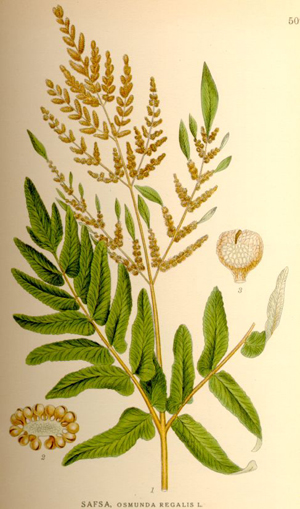|
Hardy Fern Home Osmunda resources
All Ferns � Osmundaceae �� Osmunda
�Other Genera
|
| Osmunda | ||
Royal fern | ||
|
Etymology
Of uncertain derivation: from Latin os, bone + munda, cure, because the root was a remedy for rickets; or perhaps from mundae to clean, as it was used medically to clean bones. Perhaps from Osmunder, the Saxon god of war.
Description
Rhizome: erect, massive, forming a trunk, occasionally branching, hairs and old stipe bases woven together with black, fibrous roots.
Frond: deciduous, dimorphic. Stipe: stipules (flared leaf base), unique to the family/genus, hairy when young, vascular bundles: 1 in a U-shape where the top of the arms continue to curl. Blade: 1-2-pinnate, rachis grooved, somewhat waxy, shedding water, reddish to light brown hairs. Pinnae: catadromous, often jointed at the rachis, veins free, forked. Sori: none, indusium: absent, sporangia: large, globose, tan or black when mature, spores green.
Distinctive Characteristics
The winged stipes, the vascular bundle, and the large naked sporangium without sorus or indusium, are all unique characters.
|
|
|

Osmunda regalis, claytoniana, and cinnamomea, left to right: vascular bundles at base of stipe (bottom) and apex of stipe (top). Unique to genus, indistinguishable at the species level. �Drawing from Ferns of Northeastern United States, Farida A. Wiley, 1936. |
